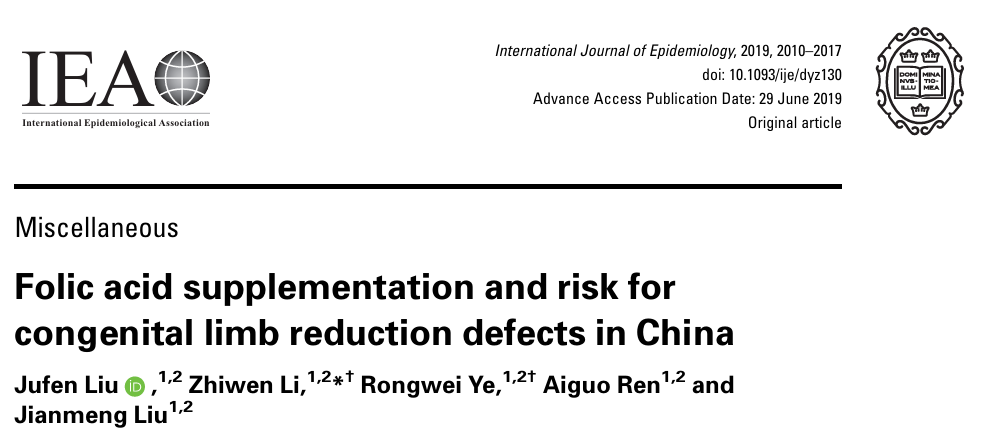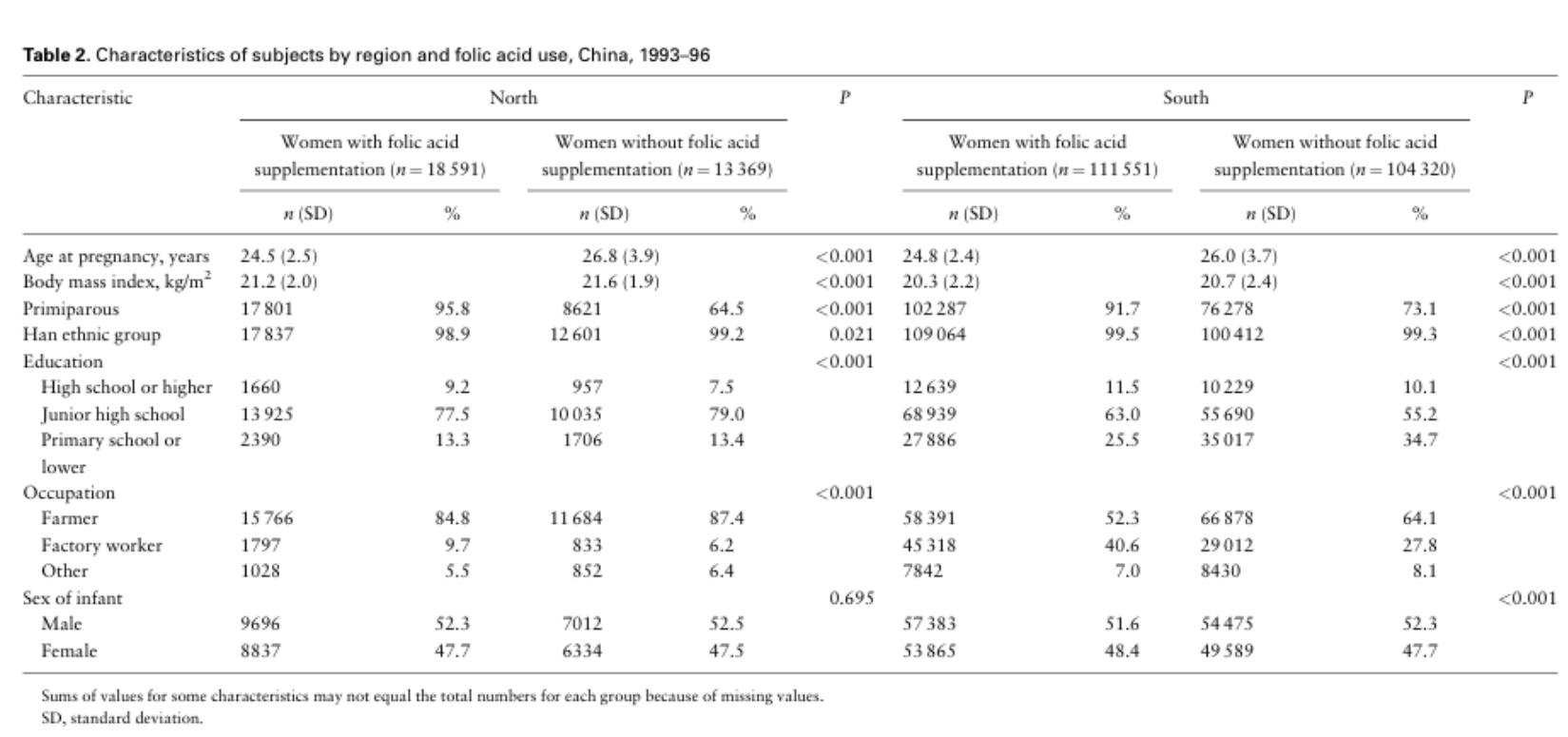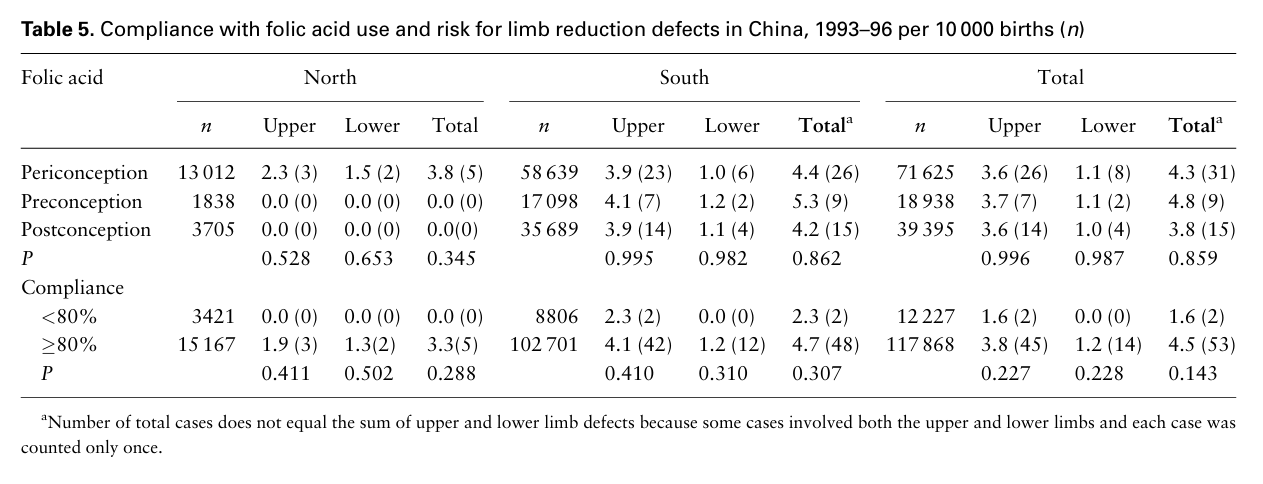
Featured research
Prof. Zhiwen Li's team published a paper in Int J Epidemiol revealing periconceptional folic acid supplementation can prevent congenital limb reduction defects

Introduction
Congenital limb reduction defects are relatively common birth defects, occurring in approximately 3–8/10 000 newborns, and varying in anatomical location, type and cause. More than half of infants with limb reduction defects have associated malformations, most commonly malformations of the cardiovascular system, urogenital system, central nervous system or digestive system. Compared with the general population, young adults with congenital lower limb reduction defects have significantly poorer physical function and reduced general and emotional health-related quality of life. The aetiology of limb reduction defects is generally thought to be multifactorial but remains largely unknown. Although early studies did not observe a protective effect of folate on limb reduction defects, more recent evidence suggests that periconceptional intake of supplements containing folic acid (FA) is associated with a decreased risk for limb reduction defects. To date, there is little evidence of the protective effect of FA alone on limb defects. Based on a prospective cohort on a public health campaign investigating the effects of FA supplementation on the prevention of neural tube defects, this study explored the effect of periconceptional supplementation with FA alone on the risk for limb reduction defects.
First Affiliation: Peking University
First author: Jufen Liu
Corresponding author: Zhiwen Li
Journal: International Journal of Epidemiology, IF2023 = 7.7, CAS 1st Quartile
Citation: Jufen Liu, Zhiwen Li*, Rongwei Ye, Aiguo Ren, Jianmeng Liu. Folic acid supplementation and risk for congenital limb reduction defects in China. International Journal of Epidemiology. 2019 Dec 1;48(6):2010-2017. doi: 10.1093/ije/dyz130.
Full Text Links: https://pubmed.ncbi.nlm.nih.gov/31257442/

Abstract
Background Folic acid (FA) supplementation prevents neural tube defects, but there are mixed results for its ability to prevent limb reduction defects. We examined whether a preventive effect of FA supplementation exists for congenital limb reduction defects in a large population in China.
Methods Data from a large population-based cohort study in China were used to evaluate the effects of FA supplementation on birth defects. All births at 20 complete gestational weeks, including live births, stillbirths and pregnancy terminations, and all structural congenital anomalies, regardless of gestational week, were recorded. A total of 247 831 singleton live births delivered at gestational ages of 20–42 weeks to women from northern and southern China with full information on FA intake were included. Limb reduction defects were classified by subtype and maternal FA supplementation.
Results The prevalence of limb reduction defects was 2.7 per 10 000 births among women who took FA compared with 9.7 per 10 000 births among those who did not take FA in northern China; the prevalence was 4.5 and 3.8 per 10 000 births, respectively, in southern China. In both unadjusted and adjusted analyses, the estimated relative risk for upper limb reduction defects [odds ratio (OR) = 0.17, 95% confidence interval (CI): 0.04, 0.63] and total limb reduction defects (OR = 0.24, 95% CI: 0.08, 0.70) in northern China, but not for lower limb reduction defects ,was significantly decreased in association with FA supplementation in northern China. There was no association between FA supplementation and either an increased or decreased risk for limb reduction defects in southern China.
Conclusions FA supplementation successfully reduces the prevalence of limb reduction defects in northern China, whose population has low folate concentrations.
Key words Folic acid supplementation, congenital limb reduction defects, upper limb
Dr Jufen Liu, Zhiwen Li and their colleagues from School of Public Health, Peking University use a large cohort study in China to explore the effect of periconceptional supplementation with FA alone on the risk for limb reduction defects. Data was from a well-organized pregnancy-monitoring system which was established in 21 counties in southern China (Zhejiang and Jiangsu) and northern China (Hebei) to collect principal records of prenatal care and demographic information. All women who were preparing for marriage or who became pregnant in the project counties were registered. All births at 20 complete gestational weeks, including live births, stillbirths and pregnancy terminations, and all structural congenital anomalies, regardless of gestational week, were recorded. The original cohort included 247 831 women who registered with the pregnancy-monitoring system between October 1993 and September 1995 and who delivered by 31 December 1996. Women who took FA pills at any time from the registration period until the end of the first trimester of pregnancy were classified as FA users. Women who did not agree to take FA or who were registered during the second trimester of pregnancy (i.e. who did not have the opportunity to start taking FA by the end of the first trimester) were considered non-users. Three patterns of FA exposure were determined according to the dates women started and stopped taking FA (see Table 1). Birth defects were identified through the Birth Defects Surveillance System for the Collaborative Project–China, which was administered by the National Center for Maternal and Infant Health at Peking University Health Science Center (PUHSC). Congenital limb reduction defects were diagnosed according to the International Classification of Diseases, Ninth Revision, Clinical Modification, as 755.2 (Reduction deformities of upper limb), 755.3 (Reduction deformities of lower limb) or 755.4 (Reduction deformities, unspecified limb).
In this large population-based cohort study, researchers observed a decrease in risk for limb reduction defects, especially upper limb reduction defects, among pregnant women who took FA supplements during the periconceptional period compared with those who did not, in northern China.

Table 2 shows selected characteristics of the 247 831 participants according to periconceptional use of FA. A total of 130 142 (52.5%) women took FA during the periconceptional period, and 117 689 (47.5%) did not take FA at all. The proportion of FA supplementation was higher in the north (58.2%) than the south (51.7%). Women who took FA were on average 1.2–2.3 years younger than and had BMIs 0.3–0.4 kg/m2 lower than women who did not take it. Women who took FA supplements were more likely to be primiparous, to be factory workers and to have higher education levels. There was a significant association between FA supplementation and infant sex in the south.
The prevalence of limb reduction defects was 2.7 per 10 000 births among women who took FA compared with 9.7 per 10 000 births among those who did not take FA in northern China; the prevalence was 4.5 and 3.8 per 10 000 births, respectively, in southern China. Upper limb reduction defects were more common than lower limb defects; there was a significant difference according to FA supplementation status in the north (Table 3).)

FA supplementation significantly prevented upper limb reduction defects (OR = 0.17, 95% CI: 0.04, 0.63) and total limb reduction defects (OR = 0.24, 95% CI: 0.08, 0.70) in northern China (Table 4).

No preventive effect of FA on limb reduction was observed in southern China. As compliance with FA use was as high as 80% to 90%, no difference in the prevalence of limb reduction defects was observed by compliance with FA use (Table 5).

Our study provides the first evidence of effects of FA supplementation alone on congenital limb reduction among a large-scale population in China. The period we observed fell before the implementation of the national FA supplementation programme, and thus the present results may reflect the true effect of natural FA concentrations of the population. The current study observed the effect of a single intervention, FA supplementation, on birth defects in the largest population in the world. It reveals that periconceptional FA supplementation can prevent congenital limb reduction defects in people with extremely low folate concentrations, those whose intake of foods containing natural folates is minimal and those who consume no food fortified with FA.
Funding
This work was supported in part by the National Key Research and Development Program, Ministry of Science and Technology, P.R. China (grant 2016YFC1000500) and National Natural Science Foundation of China (81373014 and 81202265). The original project was supported by a cooperative agreement between the US Centers for Disease Control and Prevention and Peking University (grant No. U01 DD000293).
Acknowledgement
We thank the staff members and participating women of the original trial. We also thank the two anonymous reviewers for helpful comments.
Author Biography
First author

Dr. Jufen Liu, Assistant professor (Tenure Track), Institute of Reproductive and Child Health, School of Public Health, Peking University.
Dr. Jufen Liu lead her research to investigate the early life determinants and trajectories of chronic diseases throughout the life course, through which to develop population level interventions to prevent chronic diseases and multimorbidity, as well as to support translation of discovery into policy and practice both within in China and in the global community. She has a broad interest in birth defects and disability, focusing on neurodevelopmental disorders, degenerative diseases, chronic diseases and multi-morbidities at all ages. She has led on original research articles and her publications are featured in journals such as International Journal of Epidemiology, eClinicalMedicine, Social Science and Medicine, Globalization and Health, General Psychiatry, Chinese Journal of Epidemiology, Chinese Journal of Preventive Medicine, and so forth. Her research has been recognized with awards from Huaxia Medical Science and Technology Assiociation, Chinese Preventive Medicine Association, Beijing Preventive Medicine Association and Ministry of Education, China. Dr Liu served as scientific communities, she is a standing committee member of the China Maternal and Child Health Association's Professional Committee on Perinatology and Metabolism; a member of the Chinese Preventive Medicine Association's Professional Committee on Birth Defects Prevention and Control, and the Committee on Family-School-Community Education of the Chinese Family Education Society. She is also served in the editorial boards of academic journals, including Reproductive Health (Deputy Editor), BMC Pregnancy and Childbirth (Editorial Board Member), China CDC Weekly (Guest Editor), Frontiers in Nutrition (Guest Editor), Nutrients (Guest Editor), and China Journal of Reproductive Health (Editor).
Corresponding author

Professor Zhiwen Li, Institute of Reproductive and Child Health, Peking University. His research interests are mainly focused on effects of environmental, nutritional, or lifestyle factors on adverse pregnancy outcomes such as birth defects, preterm birth, and women's health. As the principal investigator, he has presided 8 projects from National or Provincial Natural Science Funding, national or provincial key research and development projects in China, and participated in 2 national key research and development projects as key investigator. As the first or corresponding author, he has published more than 120 academic papers in international authoritative journals, e.g., J Hazard Mater, Environ Int, Int J Epidemiol. He taught the undergraduate course "birth defects and prevention" and the postgraduate course "Reproductive and Perinatal Epidemiology" and “Typical research examples in the field of reproductive and child health”. He served as Chairman of professional committee on environment and reproductive health, Chinese Association of Eugenic Science; Vice Chairman of professional committee on environment and reproductive health, Chinese Environmental Mutagen Society; Vice Chairman of professional committee on Child Brain Science and Brain Health Promotion, China Maternal and Child Health Care Association. He won the Second Prize of Science and Technology of Beijing Preventive Medicine Association. He has also been granted one Chinese invention and two utility model patent rights.
Contributed by | Dr. Jufen Liu and her research team (Peking University)
Reviewed by | ExposomeX Team
Institute Introduction

Peking University Institute of Reproductive and Child Health
Peking University Institute of Reproductive and Child Health mainly focus on the research areas of reproductive health epidemiology, environment and reproductive health, and translational research in reproductive health studies. It particularly focuses on the distribution patterns, influencing 叶酸ctors, mechanisms of disease, and prevention strategies for adverse reproductive health outcomes, utilization of big data in reproductive health, application of artificial intelligence, and related interdisciplinary transformations. The institute serves as the direct support unit for the NHC Key Laboratory of Reproductive Health (Peking University) and is specifically responsible for the National Office for Maternal and Child Health Annual Report. Its achievements have been published in top international journals such as NEJM、Lancet、JAMA、BMJ、Cell、PNAS、Science Bulletin、Lancet subsidiaries, Science subsidiaries, Nature subsidiaries, The Innovation, Environ Health Perspect, Environ Sci Technol, etc. It also hosts the core Chinese scientific journal "Chinese Journal of Reproductive Health" (Website: http://cjrh.bjmu.edu.cn/).
The outstanding talents at home and abroad are welcome for seeking job and build dream here. Contacts: Bin Wang, Vice Dean of Institute of Reproductive and Child Health of Peking University. Main page: https://sph.pku.edu.cn/info/1442/4225.htm



